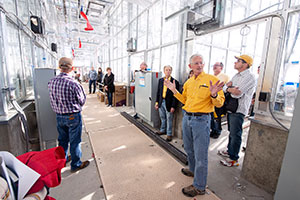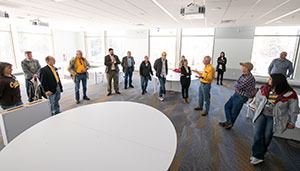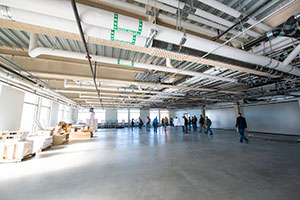
University of Wyoming students and researchers soon will have access to one of the most technologically advanced facilities in the nation with the completion of the $100 million Science Initiative Building.
The 153,000-square-foot, five-level structure joins several other UW facilities opened in recent years in the northwest section of campus focused on both undergraduate education and cutting-edge research in the science, technology, engineering and mathematics (STEM) disciplines. The project aims to help propel UW into R1 status in the Carnegie Classifications of Institutions of Higher Education, the top tier of American research universities, while also elevating the UW student experience.
“The Science Initiative Building is a new place where students can work directly in cutting-edge faculty laboratories and experience hands-on, active learning with hundreds of their peers,” UW President Ed Seidel says. “The facility also is the face of a new northwest corridor at UW that enables our students to experience hands-on learning in the introductory teaching laboratories of the Michael B. Enzi STEM Facility; the Engineering Education and Research Building for designing new tools for research; the Berry Biodiversity Conservation Center for work in core UW laboratories that measure genomes and the various molecules and their isotopes that cycle through our biosphere; and the Energy Innovation Center that is focused on finding solutions to the world’s energy challenges.”
A ribbon-cutting ceremony is scheduled Thursday, March 24, with speakers including Seidel and Science Initiative leaders. The ceremony is scheduled to begin at 8:15 a.m., followed by tours of the new building. The public is invited.
Installation and movement of equipment, faculty offices and furnishings will take place over the summer, with full use of the building expected for the fall 2022 semester.
The Science Initiative Building will be home to modern laboratory research space for faculty and students; a state-of-the-art greenhouse and plant growth areas; the Model Organism Research Facility; the Center for Advanced Scientific Instrumentation; and an active-learning classroom and collaborative spaces for undergraduate and graduate education and research.
“The Science Initiative Building is a welcome and much-needed expansion of life-science research space on campus. The open-concept design of the labs will allow researchers like myself to realize new efficiencies and establish new collaborative relationships,” says Professor Jay Gatlin, head of UW’s Department of Molecular Biology. “I get particularly excited when I think about how my lab’s research will benefit from the Center for Advanced Scientific Instrumentation. This center will provide access to amazing cutting-edge instrumentation previously unavailable to researchers at UW and will likely have a profound impact on research across campus and throughout the state of Wyoming.”
Origins
In 2014, a panel of accomplished scientists, industry leaders and other professionals endorsed a plan to improve science education and student success at UW while creating world-class facilities to propel research on issues important to the state and nation. The Wyoming Governor’s Top-Tier Science Programs and Facilities Task Force, chaired by former Gov. Dave Freudenthal and distinguished UW alumna Carol Brewer, emphasized collaboration among multiple disciplines by assembling researchers into a single complex with shared instrumentation, technical support and collaboration spaces.
With appropriations by the Wyoming Legislature and then-Gov. Matt Mead, ground was broken for the building at the corner of Ninth and Lewis streets in November 2018. The construction manager is Jackson-based GE Johnson.
In addition to a new building, the task force’s 2014 report called for robust training and mentoring programs for science department faculty members in active-learning practices, along with more research opportunities for students through enhanced faculty mentoring, training programs and internships.
Since that time, the Science Initiative’s Learning Actively Mentoring Program has trained over 100 faculty members and graduate students in active learning -- an instructional approach that uses collaborative work among small groups of students and instructors, with traditional lectures replaced by a variety of learning opportunities including short interactive lectures, small-group discussions, case studies and web-based opportunities outside of class. At the same time, the Science Initiative’s Wyoming Research Scholars Program has paired 154 UW undergraduate students with faculty mentors to participate in their own cutting-edge research projects.
Additionally, Science Initiative “roadshows” have taken active-learning experiences to K-12 schools across Wyoming. And the Science Initiative’s Faculty Innovation Grant Program has been launched to stimulate and bolster submission of interdisciplinary grant proposals to federal research agencies.
With those foundational programs in place and the Science Initiative Building ready to open, the first phase of the Science Initiative is unfolding in a manner that promises to improve educational and research opportunities for hundreds of UW students and dozens of researchers.
“Every square foot of this building will have a positive impact on undergraduate students. Our No. 1 goal is to have a positive impact on the greatest number of undergraduate students as possible,” says Greg Brown, a UW botany professor and Science Initiative stalwart who is now the part-time executive operations director for the new building. “We believe this is the best high-tech research facility in the Rocky Mountain West for active learning and research.”
“The whole building models what the university is all about -- teaching, research, service and outreach,” says Mark Lyford, an academic professional in the Department of Botany who is the executive program director of the Science Initiative. “We expect to touch the whole state through this building.”

A Venue for Active Learning
The 5,000-square-foot active-learning classroom will be used in the fall semester for all of UW’s introductory biology (LIFE 1010) classes -- large courses that can have up to 200 students each. Other courses scheduled to be taught there this fall are higher-level courses in microbial genetics, human systems physiology, organic chemistry, chemistry and physiology. Students will sit at tables -- up to nine per table -- and instructors will be able to move among the groups after delivering short introductions to lessons.
The classroom has technology specifically designed so that instructors won’t need to carry microphones and so that student groups will be able to work together without noise disruption. Microphones and speakers will be placed at multiple locations and controlled with a computer that isolates the audio as needed for different situations.
“This will be transformative for our faculty who are using active-learning methods, because other physical spaces on campus limit what they can do,” Lyford says. “Now, our faculty will be able to do all of the things they’ve wanted with active learning. We’ve already seen a significant impact on student success in our LIFE 1010 classes, which traditionally are quite challenging for students, and we expect this classroom will help us take it even further.”
High-Tech Greenhouses and Growth Chambers
One of the most notable features of the Science Initiative Building is its 6,000-square-foot complex of research and teaching greenhouses on top of the building, along with separate plant growth chambers in the interior of the building where light can be controlled. Brown describes the facilities -- “the best to be found west of the Mississippi and, possibly, the entire U.S.” -- as a major leap forward for research important to Wyoming and the nation.
“The Science Initiative Building Plant Growth Facility will fundamentally change how we address plant biology questions that will enable future agriculture and biodiversity conservation in our state and region,” says botany Professor Brent Ewers, who heads UW’s EPSCoR (Established Program to Stimulate Competitive Research) program. “We can now completely control all of the physical environments of plants -- humidity, temperature, light and carbon dioxide levels -- so that we can better perform experiments and cutting-edge measurements. We will be able to test new imaging technologies that will place UW at the cutting edge of the plant biotechnology revolution. Our new plant imagers will be the future sensors placed on tractors and drones that will improve the Wyoming agriculture economy.”
“Our lab is particularly excited about the new research-grade greenhouses, which will offer greatly improved control over the test environments experienced by our plants,” says botany Professor Cynthia Weinig, who holds a Wyoming Excellence Chair and does advanced research on plant genetics. “Further, the Science Initiative Building will allow for automated measurements of plant traits and, thus, allow our lab and others to more rapidly test how different treatments affect plant growth. For instance, we are currently funded by the National Science Foundation (NSF) to test how microbes found in the soil affect plant growth, either favorably or unfavorably. As one might guess, these microbial communities can be quite sensitive to environmental changes.”
One of her research group’s important findings is that local microbes can affect performance of plants in the wild, as well as some crops. The work has included two Wyoming Research Scholars, Ella DeWolf and Ayda Lewis.
“We hope to continue related work in the new building and continue including undergraduate students in our work,” Weinig says.
Research Labs
As many as two dozen UW faculty members will use research laboratories in the Science Initiative Building, which have been designed as shared spaces that can be rapidly modified for different purposes.
While the initial roster of faculty using the building has not been finalized, Brown says it’s likely to include researchers in geology, zoology, ecosystem science, botany and molecular biology, among others.
“UW is known for its research into flora, fauna and geology, all of which is so important to Wyoming, and you’ll see this intersection across many research groups,” Brown says. “We’ll essentially be doing research here at the molecular, cellular, organismal and ecosystem spatial levels, as well as at temporal levels from seconds to thousands of years.”
Users of the labs will be determined by an executive committee focused on making the spaces available to the university’s most promising, productive researchers in areas of importance to Wyoming. It’s expected that, through a competitive selection process, the lineup of Science Initiative Building researchers will be dynamic over time.
The spaces also are designed to encourage interdisciplinary interactions -- so-called “collision spaces” -- among UW researchers from different disciplines.
“The physical space will lead to collaborations that aren’t likely to happen otherwise,” Brown says.
For example, Ewers says a $20 million grant from NSF’s EPSCoR allowed UW to combine various disciplines -- from soil microbiology and biogeochemistry to genomics, computational biology and data science -- “but our students, faculty and postdocs were scattered around UW. Through the Science Initiative Building, we are able to physically collaborate with one another and increase daily ‘collisions,’ leading to new science outcomes,” he says.
Top-Level Instrumentation
Located primarily on the building’s first floor, the Center for Advanced Scientific Instrumentation (CASI) will be the core instrument facility for the university, enhancing research across all foundational and applied sciences at UW.
CASI will be the home of high-tech instruments including electron microscopes, an X-ray refractometer, a mass spectrometer and micro CT scanners. Some of the equipment is coming from other areas of campus; other pieces are being acquired with American Rescue Plan Act funding.
Brown notes that CASI’s first-floor location and special construction help provide a crucial vibration-free environment for the sensitive instruments -- allowing researchers to “achieve unprecedented sensitivities and efficiencies in probing the fundamental interactions among atoms, molecules and cells that underlie all next-generation technologies.”
CASI also extends to a second-level space where the public will be able to view the high-tech machines in use.
Research Using Animals

The Science Initiative’s Model Organism Research Facility (MORF), meanwhile, will bring together UW’s world-recognized biologists into a single collaborative space to foster innovation and convergent research activities addressing some of Wyoming’s most pressing environmental and health-related challenges.
MORF will be organized around state-of-the-art laboratory animal research facilities specially designed for studies using model and transgenic organisms with appropriate safeguards.
While additional funding is being sought to complete MORF, it will get its start with an aquatics holding facility for frogs used in research by Gatlin and fellow molecular biology Professor Dan Levy. Their research uses frog cells to pursue potential treatments for cancer and other human diseases.
Eventually, MORF will be a central laboratory for the many UW scientists who use small animals such as mice and rats in their research.
Room to Grow
About 12 percent of the Science Initiative Building, or 18,000 square feet, is unfinished, “shelled” space for expanded and new programs as funding becomes available.
For example, about 1,400 square feet is available to expand CASI for additional scientific instruments. And Science Initiative approved plans including completing a 7,000-square-foot area on the fourth level for the Student Collaborative Research, Outreach and Learning Laboratory (SCROLL). Lyford says SCROLL will be a one-of-a-kind in the nation, student-focused facility that will transform the research, learning and outreach experiences of UW’s STEM students and K-12 students across the state.
The Science Initiative Building was constructed to accommodate other programmatic pieces of the Science Initiative that have not yet been funded, such as the Competitive Research Innovation Program for faculty research. The current level of funding for Science Initiative programming is at 26 percent of what was envisioned by the Wyoming Governor’s Top-Tier Science Programs and Facilities Task Force.

